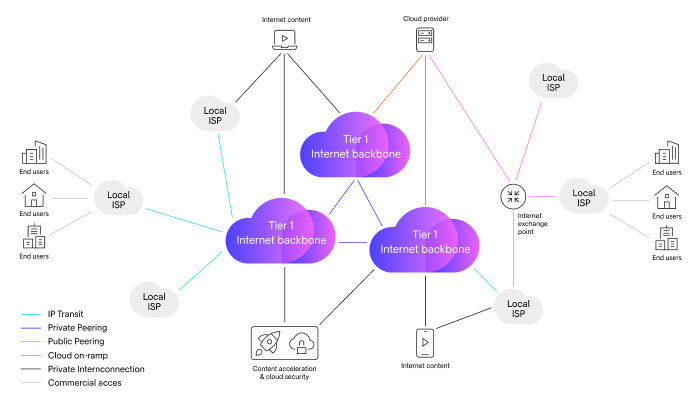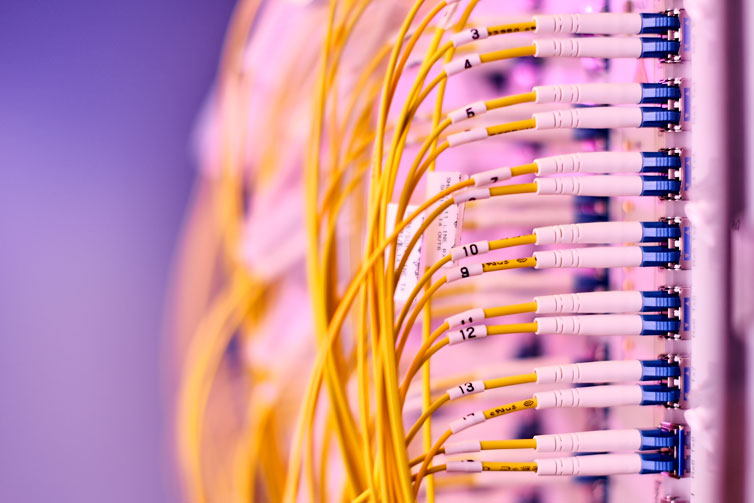The public Internet is a complex mesh of almost one hundred thousand different, but ‘open’ networks - linked together with an almost limitless inventory of network hardware and millions of kilometers of fiber-optic cable. In technical terms, these are known as Autonomous Systems (AS). An AS is essentially a unique collection of IP addresses/address blocks and network hardware within a common administrative domain. Autonomous Systems communicate route information and steer traffic to each other using a protocol known as the Border Gateway Protocol, or BGP.
As a Tier 1 network owner we can reach every other network on the Internet solely via settlement-free interconnection. Our AS1299 is currently ranked #1 and our IP customers account for nearly 72% of all Internet routes. Whether you're a startup or Fortune 500, our network is the backbone of your business - connecting you directly to everything and everyone that matters.
While the Internet backbone forms the backbone of the Internet, no single entity owns or controls the entire Internet. Even control of the Internet is not regulated on a common level, though some governments have been trying to introduce a more controlled Internet for their specific location, but on the global level, there is no organized control.
Internet infrastructure is on the other hand owned by some large communication companies.

Whilst Internet connectivity is often viewed as a commodity, performance can vary significantly between suppliers. When selecting an Internet backbone, there are a number of important things to consider:
Reach - a larger footprint generally means a service provider has greater control of network resources, and ultimately, quality.
Scalability - is a backbone built on leased capacity or own infrastructure? This will dictate the ability of a supplier to scale-up capacity, quickly and efficiently.
Proximity - How well connected is a backbone with the rest of the Internet and in what tier do they reside?
Connectivity – Does a backbone connect via third party transit networks and public exchanges or through a well-managed ecosystem of private peering connections with critical networks?
Internet backbone maps depict the connections between different points of presence (PoP), making it easier for customers to see and define the shortest way to connect keeping the best possible quality and cost.
See Arelion’s Network maps as a good example.
Internet backbone maps show our core network infrastructure that is the foundation of the Internet across the continent. The maps provide a detailed overview of the key routes, connections and high-capacity data transmission lines that enable data traffic across the United States and its connection to the global Internet.
We use our own optical fiber backbone that spans thousands of kilometers across the world. We control, operate, and monitor all our routes to ensure cable stretches and exact fiber routings are thoroughly checked, documented, and maintained. We apply a rigorous process to all fiber routes, including fast, in-field action for fiber repairs to maintain high fiber availability.

Optical fibers are the most common media for data transmission and connections between different Internet backbones. Satellite-based radio links and subsea cables are also deployed across long distances and where land-based optical cable connections are not feasible. Other important Internet backbone components are high-performance routers, switches and servers that play a crucial role in directing and managing the flow of data packets.
Internet backbones interconnect via so-called Points of Presence (PoPs) which are often located within or near Internet exchange points (IXes) in order to minimize distance and increase performance between different networks.
Having a direct connection to the Internet backbone is crucial for some customer groups and organizations, including ISPs, Cloud providers (data centers), hyperscalers and large enterprises.
While the actual connection process can be fairly straight-forward, some planning and decision-making steps can be time-consuming. These encompass everything from developing an interconnection strategy to selecting appropriate providers and IXPs, establishing peering agreements and implementing redundancy and appropriate security measures. On top of that regulatory compliance needs to be considered.
Every organization is unique, and so are their connectivity needs.
In simple terms, there are two main options:
For organizations without the need for an AS number
Organizations without their own Autonomous System (AS) number will need to connect via an Internet Service Provider. An AS number is necessary for routing traffic between networks at the Internet core, and the Border Gateway Protocol (BGP) is used to announce IP address prefixes and network changes to the global Internet routing table.
However, smaller to medium-sized entities or individual users don't have their own AS number and rely on more comprehensive Internet services provided by Internet Service Providers (ISPs) or third-party networks with their own AS instead. This spares them the complexity and administrative overhead of maintaining their own AS number.
At Arelion, we provide a Dedicated Internet Access (DIA) solution tailored for this purpose. Our offering combines guaranteed bandwidth, and symmetrical bandwidth, with the management of customer IP addresses and oversight of the BGP routing environment. This ensures reliable, direct, and dedicated Internet access.
Organizations with their own AS number
Organizations with their own AS numbers can establish a resilient and direct link to the Internet with IP Transit and BGP routing. This affords them greater control of their network traffic and allows them to take full advantage of the reliability and scalability of their selected transit network provider(s).
For three decades, IP Transit has been the cornerstone of Arelion’s operations, establishing a one-hop connection to 95% of end-users in the US and Europe.
As a Tier 1 network provider, Arelion maintains direct connections with all other Tier 1 networks, enabling seamless access to any destination on the Internet without the need for intermediary providers. This ensures a swift and dependable network connection with minimal latency. By incorporating industry-leading practices, advanced systems, and well-crafted policies, we mitigate the risks associated with common routing issues such as BGP hijacks, route leaks, etc.
The Internet backbone ensures global connectivity by interconnecting major networks through high-capacity fiber-optic cables and high-performance routers. This infrastructure supports the rapid transmission of data across vast distances, maintaining low latency and high reliability.
Critical components of the Internet backbone include optical fiber cables, high-performance routers, switches, and servers. These components work together to manage and direct the flow of data packets across the network. Points of Presence (PoPs) and Internet Exchange Points (IXPs) are more crucial as the on-off stops of the Internet. They provide the physical interconnection points without which the wider Internet structure would be unviable.
When selecting an Internet backbone provider, consider factors such as network reach, scalability, proximity to other major networks, and connectivity options. A provider with a larger footprint has better control over network resources and quality. It's also important to assess whether the backbone uses leased capacity or owns its infrastructure, as this impacts scalability and efficiency.
